Community-Managed Water Supply System and Rainwater Harvesting Facility
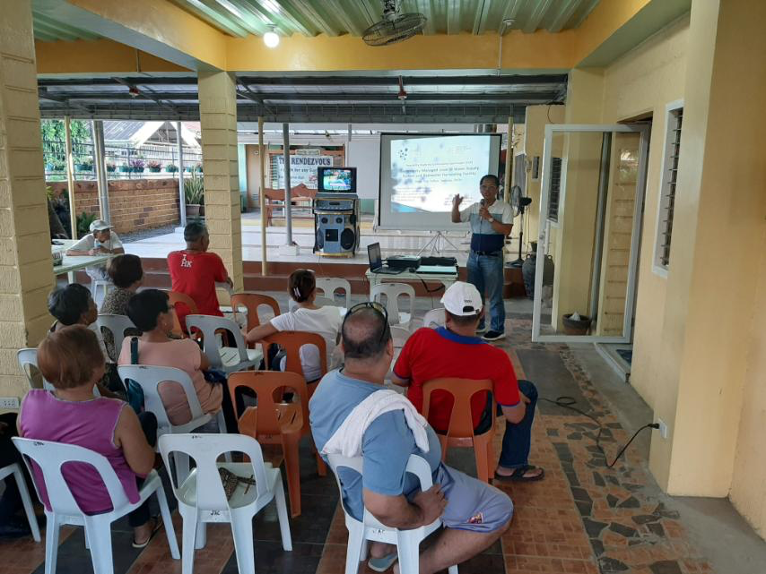
Introduction
The community of Barangay San Julian, located in the center of the Municipality of Janiuay, Iloilo regularly experiences severe water scarcity for six straight months during the dry season. The town’s water supply company cannot adequately provide the water needs of the community because the underground water sources have been overused and are now insufficient to supply the residents. The lack of reliable water supply affects the development of the community and causes inconvenience, sanitation problems and health risks for its residents. Climate changewill worsen the community’s water scarcity problem. Mid-range projections from the Philippine Atmospheric, Geophysical and Astronomical Services Administration (PAGASA) indicate rainfall will increase during the rainy months of December to May, and decrease from September to November. This increased rainfall variability will potentially affect agriculture and irrigation, water supplies and water table replenishment in the municipality.

Municipality of Janiuay, Iloilo faces flooding during rainy seasons and severe water shortage during the dry season. Photo Credit: PRRM
This project page presents the project “Community-Managed Water Supply System and Rain-Water Harvesting Facility”, whichaims to strengthen community resilience to water scarcity through enhanced water security.
Methodology
The community-led project (CLP) places urban poor communities as activeand informedparticipantsat the centre of the process of resilience planning, from assessment to implementation,andgives them a role in the maintenance ofcommunity-led projects.Through the Community Resilience Planning (CRP) process,people from poor and vulnerable groups work together with other stakeholders from government and the private sector to collect and analyse data about how hazards impact vulnerable groups and livelihoods and design and agree resilience solutions. TheCommunity Resilience Planning process requires strong social mobilization, communication and engagementwith all stakeholders. It also requires the creation of the Community Stakeholder Group (CSG), an institutional and multi-sectoral mechanism for transparent and effective information sharing, decision-making and implementation of community decisions and actions.
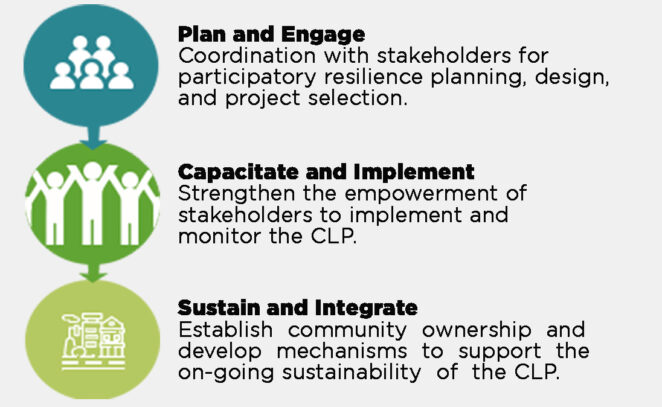
Community-Led Resilience Project
Through the CRP process, community members decided to take collective action to address the problem of water scarcity and developedaproject called “Community-Managed Water Supply System and Rain-Water Harvesting Facility”.The project aims to strengthen community resilience to water scarcity through enhanced water security.The projectwill construct and maintain acommunity-managed water system and community rainwater harvesting facility. The water supply system will draw water from a reliable underground water source, pump it to anover-head storage tank,processthe watervia afiltrationfacilityand distribute the water tohouseholdsviaa community-wide pipe system. The project will alsoplant water-retaining trees withinand on hills aroundthe watershed to help replenish groundwater.
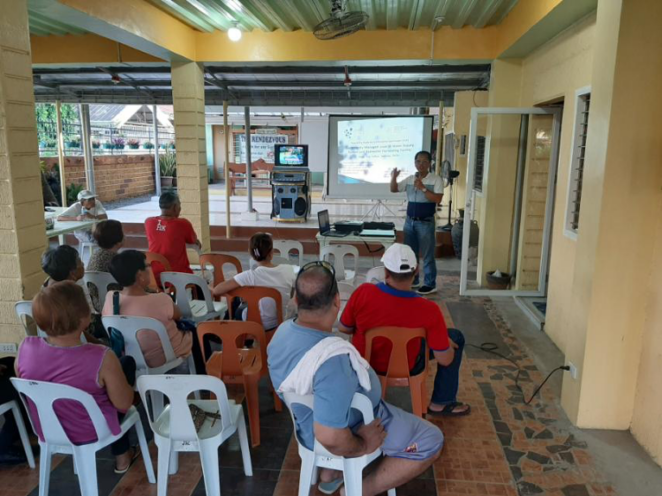
Innovations
The community rainwater harvestingsystem will collectrainwater through a network of catchments and feeder roofs andwillstore the water in an underground cistern for future use. The cistern is made of several chambers for leaching and sludge settlement, filtration, and clean water storage. Clean waterwill bepumped out of the cistern into an over-head tank,where it will bechlorinated before being distributed to households via gravity.The rainwater harvesting systemwillprovide additional water storageto augment the community’s existing water supply. It will helpreduce groundwater extraction and depletion andcreate more time for groundwater to be sustainably recharged.The rainwater will be usedfor domestic purposes such as cleaning, washing,andflushing of toilets,especially duringperiods of drought anddisasters, and whenthewater supply is disruptedbypower outages.
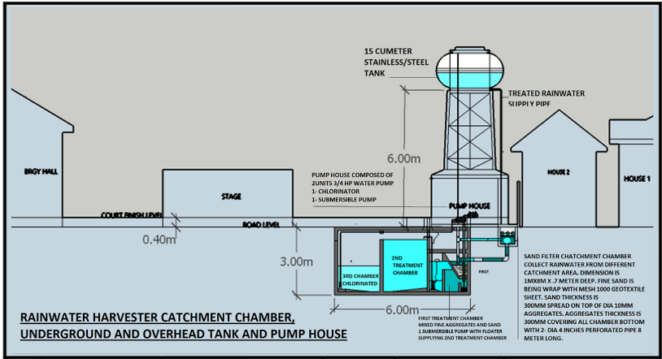
Gender and Social Inclusion
To achieve the effective management of water in water scarce areas such asJaniuay, a gender lens needs to be applied. A gender analysis will reveal the gender norms that determine whohas access to water, and who can use water at the household level and for what purposes. Distributing water via water distribution lines can reduce the burden of women’s unpaid work dedicated to fetching water. However, if women are to truly benefit, it is important that the time saved is not allocated to other unpaid household duties. Whilst re-using wastewater is good for water management, it should be carried out in a way that also reduces the burden of unpaid household work for women.
Issues and Challenges
The implementation ofthe community-based water supply system encounteredseveral challenges including limited water supply sources in the area and the over-use of groundwater, limited space for setting up the rainwater harvesting facility,andalack of technical and operational capacity to manage and maintain the water supply system and the rainwater harvesting facility within the community.Theproject willenhance the capacities ofthecommunity stakeholder group (CSG) which will support the ongoing maintenance of thewater supply system.The project will also developlivelihood opportunities thatwill support the ongoing sustainability of the water system. The CSG, with assistance from the project’s community resilience officer (CRO)will seek tosecure institutional local government funding through the municipality’s annual budget tosupportpart, or all of the ongoing operational and maintenance costs.
Expected Results and Impact of the Project
A community-based water cooperative and the barangay will be responsible for the management and operation of the water supply system and the rainwater harvesting facility.The projectwillprovide the community with alternative, reliable and continuous water for drinking, domestic use, economic activities and livelihoodsand additional co-benefitssuch aspreparing for drought, fire and other disasters which are expected to increase in frequency and severity in the future, due totheimpacts of climate change.
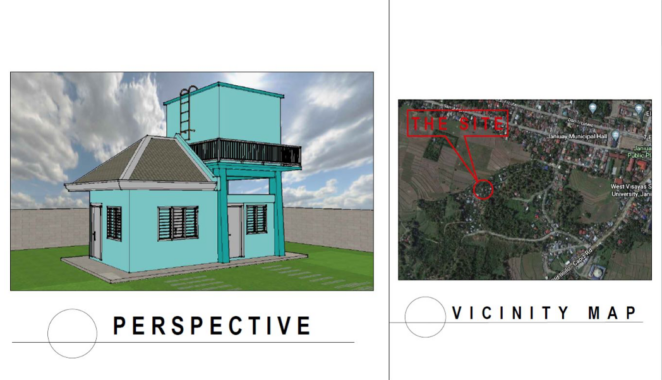
The project is expected to create significant social,environmental,financial and economic benefitsfor the Barangay San Julian community.Aside from the expected financial contributions of the municipality, the water tariffs are expected to generate monthly revenues that can financially support the operation of thewater system.The profitswillbe used forsystemupkeep and upgrading,capital improvements, maintenance and replacement of equipmentand parts such as pumps,andmotors.
The project is still ongoing and is funded and supported by the Asian development bank through the Urban Climate Change Resilience Trust Fund (ADB-UCCRTF) and implementedby Oxfam in partnership with the Philippine Rural Reconstruction Movement (PRRM).
About UCCRTF. The Urban Climate Change Resilience Trust Fund is a $150 million multi-donor trust fund (2013-2021) administered by the Asian Development Bank under the Urban Financing Partnership Facility. With funding from the Rockefeller Foundation and the Governments of Switzerland and the United Kingdom, it aims to support fast-growing cities in Asia to reduce the risks poor and vulnerable people face from floods, storms or droughts, by helping to better plan and design infrastructure to invest against these impacts.
ADB-RETA 9329. Oxfam and local partner Philippine Rural Reconstruction Movement is implementing ADB-RETA 9329 Promoting Urban Climate Change Resilience in Selected Asian Cities Subproject 3 (SP3): Pilot and Project Development Activities. The goal of the project is to contribute to climate change resilience by empowering vulnerable communities through community-led initiatives. The project is implemented in 9 pilot communities in Bangladesh, Pakistan, Philippines and Myanmar.
Contact details
Dr. Virinder Sharma
Senior Urban Development Specialist
Asian Development Bank
Sharon Taylor
Project Manager (Philippines)
Philippine Rural Reconstruction Movement
Jose Arianne Gonzales
Communications and Knowledge Management Specialist
Oxfam Great Britain
[email protected]
Citation
Jeans, H., Deocariza, M., Gonzalez, J.A., Taylor, S. and Flores, R. (2021) Community-Managed Water Supply System and Rainwater Harvesting Facility. On weADAPT, the Collaborative Platform on Climate Change Adaptation.
Further readings
Related resources
- Roof catchment rainwater harvesting system for off-season small-scale irrigation
- Construction of Water Harvesting Infrastructure and improving the Community’s Adaptive Capacity to Natural Hazards
- Siargao Urban Resilient Future (Del Carmen SURF) Project
- Building Resilience to Floods and Rain-Induced Landslides in Barangay Napaan
- Climate Resilient Community-Managed Flood Mitigation Project in La Trinidad, Benguet
(0) Comments
There is no content